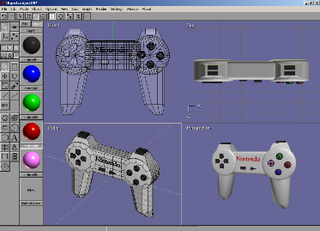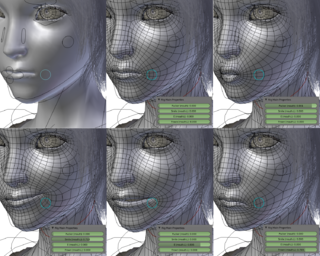Autodesk 3ds Max, formerly 3D Studio and 3D Studio Max, is a professional 3D computer graphics program for making 3D animations, models, games and images. It is developed and produced by Autodesk Media and Entertainment. It has modeling capabilities and a flexible plugin architecture and must be used on the Microsoft Windows platform. It is frequently used by video game developers, many TV commercial studios, and architectural visualization studios. It is also used for movie effects and movie pre-visualization. 3ds Max features shaders, dynamic simulation, particle systems, radiosity, normal map creation and rendering, global illumination, a customizable user interface, and its own scripting language.

Wings 3D is a free and open-source subdivision modeler inspired by Nendo and Mirai from Izware. Wings 3D is named after the winged-edge data structure it uses internally to store coordinate and adjacency data, and is commonly referred to by its users simply as Wings.
In computing, D3DX is a high level API library which is written to supplement Microsoft's Direct3D graphics API. The D3DX library was introduced in Direct3D 7, and subsequently was improved in Direct3D 9. It provides classes for common calculations on vectors, matrices and colors, calculating look-at and projection matrices, spline interpolations, and several more complicated tasks, such as compiling or assembling shaders used for 3D graphic programming, compressed skeletal animation storage and matrix stacks. There are several functions that provide complex operations over 3D meshes like tangent-space computation, mesh simplification, precomputed radiance transfer, optimizing for vertex cache friendliness and strip reordering, and generators for 3D text meshes. 2D features include classes for drawing screen-space lines, text and sprite based particle systems. Spatial functions include various intersection routines, conversion from/to barycentric coordinates and bounding box and sphere generators.

Skeletal animation or rigging is a technique in computer animation in which a character is represented in two parts: a surface representation used to draw the character and a hierarchical set of interconnected parts, a virtual armature used to animate the mesh. While this technique is often used to animate humans and other organic figures, it only serves to make the animation process more intuitive, and the same technique can be used to control the deformation of any object—such as a door, a spoon, a building, or a galaxy. When the animated object is more general than, for example, a humanoid character, the set of "bones" may not be hierarchical or interconnected, but simply represent a higher-level description of the motion of the part of mesh it is influencing.

In 3D computer graphics and solid modeling, a polygon mesh is a collection of vertices, edges and faces that defines the shape of a polyhedral object. The faces usually consist of triangles, quadrilaterals (quads), or other simple convex polygons (n-gons), since this simplifies rendering, but may also be more generally composed of concave polygons, or even polygons with holes.

In computer graphics, a shader is a computer program that calculates the appropriate levels of light, darkness, and color during the rendering of a 3D scene—a process known as shading. Shaders have evolved to perform a variety of specialized functions in computer graphics special effects and video post-processing, as well as general-purpose computing on graphics processing units.

Anim8or is a freeware OpenGL-based 3D modeling and animation program by R. Steven Glanville, a software engineer at NVidia. Currently at stable version 1.01.1402, it is a compact program with several tools which would normally be expected in high-end, paid software. To date, every version released has been under 3 MB, despite the fact that it does not make full use of Windows' native interface, carrying some graphical elements of its own. Although few official tutorials have been posted by the author, many other users have posted their own on sites such as YouTube and the anim8or home page. While Anim8or was once comparable to other freeware 3D animation software such as Blender, it has seen less progression in recent years, with Blender now being more capable than before.

Subsurface scattering (SSS), also known as subsurface light transport (SSLT), is a mechanism of light transport in which light that penetrates the surface of a translucent object is scattered by interacting with the material and exits the surface at a different point. The light will generally penetrate the surface and be reflected a number of times at irregular angles inside the material before passing back out of the material at a different angle than it would have had if it had been reflected directly off the surface. Subsurface scattering is important for realistic 3D computer graphics, being necessary for the rendering of materials such as marble, skin, leaves, wax and milk. If subsurface scattering is not implemented, the material may look unnatural, like plastic or metal.
OBJ is a geometry definition file format first developed by Wavefront Technologies for its Advanced Visualizer animation package. The file format is open and has been adopted by other 3D graphics application vendors.
In 3D computer graphics, polygonal modeling is an approach for modeling objects by representing or approximating their surfaces using polygon meshes. Polygonal modeling is well suited to scanline rendering and is therefore the method of choice for real-time computer graphics. Alternate methods of representing 3D objects include NURBS surfaces, subdivision surfaces, and equation-based representations used in ray tracers.

The Blender Game Engine was a free and open-source 3D production suite used for making real-time interactive content. It was previously embedded within Blender, but support for it was dropped in 2019, with the release of Blender 2.8. The game engine was written from scratch in C++ as a mostly independent component, and includes support for features such as Python scripting and OpenAL 3D sound.

Pixologic ZBrush is a digital sculpting tool that combines 3D/2.5D modeling, texturing and painting. It uses a proprietary "pixol" technology which stores lighting, color, material, orientation and depth information for the points making up all objects on the screen. The main difference between ZBrush and more traditional modeling packages is that it is more akin to traditional sculpting.

UV mapping is the 3D modeling process of projecting a 3D model's surface to a 2D image for texture mapping. The letters "U" and "V" denote the axes of the 2D texture because "X", "Y", and "Z" are already used to denote the axes of the 3D object in model space, while "W" is used in calculating quaternion rotations, a common operation in computer graphics.
Mudbox is a proprietary computer-based 3D sculpting and painting tool. Currently developed by Autodesk, Mudbox was created by Skymatter, founded by Tibor Madjar, David Cardwell and Andrew Camenisch, former artists of Weta Digital, where it was first used to produce the 2005 Peter Jackson remake of King Kong. Mudbox's primary application is high-resolution digital sculpting, texture painting, and displacement and normal map creation, although it is also used as a design tool.
PLY is a computer file format known as the Polygon File Format or the Stanford Triangle Format. It was principally designed to store three-dimensional data from 3D scanners. The data storage format supports a relatively simple description of a single object as a list of nominally flat polygons. A variety of properties can be stored, including color and transparency, surface normals, texture coordinates and data confidence values. The format permits one to have different properties for the front and back of a polygon.

Digital sculpting, also known as sculpt modeling or 3D sculpting, is the use of software that offers tools to push, pull, smooth, grab, pinch or otherwise manipulate a digital object as if it were made of a real-life substance such as clay.
Simplygon is 3D computer graphics software for automatic 3D optimization, based on proprietary methods for creating levels of detail (LODs) through Polygon mesh reduction and other optimization techniques.

Modo is a polygon and subdivision surface modeling, sculpting, 3D painting, animation and rendering package developed by Luxology, LLC, which is now merged with and known as Foundry. The program incorporates features such as n-gons and edge weighting, and runs on Microsoft Windows, Linux and macOS platforms.

Morph target animation, per-vertex animation, shape interpolation, shape keys, or blend shapes is a method of 3D computer animation used together with techniques such as skeletal animation. In a morph target animation, a "deformed" version of a mesh is stored as a series of vertex positions. In each key frame of an animation, the vertices are then interpolated between these stored positions.
This is a glossary of terms relating to computer graphics.











